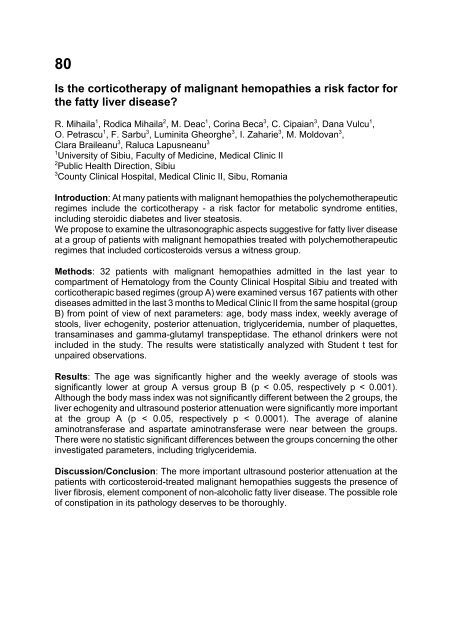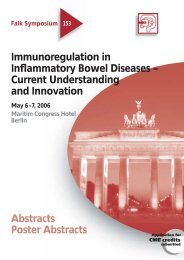Abstracts Poster Abstracts - Dr Falk
Abstracts Poster Abstracts - Dr Falk
Abstracts Poster Abstracts - Dr Falk
You also want an ePaper? Increase the reach of your titles
YUMPU automatically turns print PDFs into web optimized ePapers that Google loves.
80Is the corticotherapy of malignant hemopathies a risk factor forthe fatty liver disease?R. Mihaila 1 , Rodica Mihaila 2 , M. Deac 1 , Corina Beca 3 , C. Cipaian 3 , Dana Vulcu 1 ,O. Petrascu 1 , F. Sarbu 3 , Luminita Gheorghe 3 , I. Zaharie 3 , M. Moldovan 3 ,Clara Braileanu 3 , Raluca Lapusneanu 31 University of Sibiu, Faculty of Medicine, Medical Clinic II2 Public Health Direction, Sibiu3 County Clinical Hospital, Medical Clinic II, Sibu, RomaniaIntroduction: At many patients with malignant hemopathies the polychemotherapeuticregimes include the corticotherapy - a risk factor for metabolic syndrome entities,including steroidic diabetes and liver steatosis.We propose to examine the ultrasonographic aspects suggestive for fatty liver diseaseat a group of patients with malignant hemopathies treated with polychemotherapeuticregimes that included corticosteroids versus a witness group.Methods: 32 patients with malignant hemopathies admitted in the last year tocompartment of Hematology from the County Clinical Hospital Sibiu and treated withcorticotherapic based regimes (group A) were examined versus 167 patients with otherdiseases admitted in the last 3 months to Medical Clinic II from the same hospital (groupB) from point of view of next parameters: age, body mass index, weekly average ofstools, liver echogenity, posterior attenuation, triglyceridemia, number of plaquettes,transaminases and gamma-glutamyl transpeptidase. The ethanol drinkers were notincluded in the study. The results were statistically analyzed with Student t test forunpaired observations.Results: The age was significantly higher and the weekly average of stools wassignificantly lower at group A versus group B (p < 0.05, respectively p < 0.001).Although the body mass index was not significantly different between the 2 groups, theliver echogenity and ultrasound posterior attenuation were significantly more importantat the group A (p < 0.05, respectively p < 0.0001). The average of alanineaminotransferase and aspartate aminotransferase were near between the groups.There were no statistic significant differences between the groups concerning the otherinvestigated parameters, including triglyceridemia.Discussion/Conclusion: The more important ultrasound posterior attenuation at thepatients with corticosteroid-treated malignant hemopathies suggests the presence ofliver fibrosis, element component of non-alcoholic fatty liver disease. The possible roleof constipation in its pathology deserves to be thoroughly.



